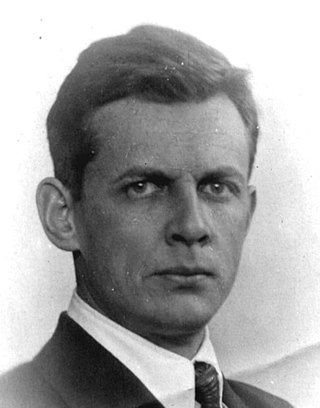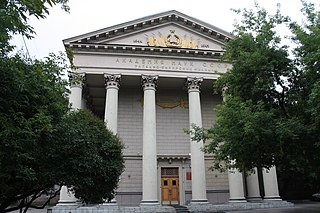
Boris Borisovich Rohdendorf was a Soviet entomologist and curator at the Zoological Museum at the Moscow University. He attained the position of head of the Laboratory of Arthropods, Paleontological Institute, Russian Academy of Sciences, Academy of Sciences of the Soviet Union in Moscow. A student of Andrey Martynov, he was a prolific taxonomist who described numerous new taxa, including fossil Diptera, and published important syntheses on fossil insects. His work is being extensively revised by the current generation of Russian paleoentomologists.
Grigory Yakovlevich Bey-Bienko was a Soviet and Russian entomologist who specialized in Orthoptera.

Nikolai Sergeevich Borchsenius was a Russian entomologist who specialised in the Coccoidea.

Diaspididae is the largest family of scale insects with over 2650 described species in around 400 genera. As with all scale insects, the female produces a waxy protective scale beneath which it feeds on its host plant. Diaspidid scales are far more substantial than those of most other families, incorporating the exuviae from the first two nymphal instars and sometimes faecal matter and fragments of the host plant. These can be complex and extremely waterproof structures rather resembling a suit of armor. For this reason these insects are commonly referred to as armored scale insects. As it is so robust and firmly attached to the host plant, the scale often persists long after the insect has died.

Yevgeny Nikanorovich Pavlovsky was a Soviet zoologist, entomologist, academician of the Academy of Sciences of the Soviet Union (1939), the Academy of Medical Sciences of the USSR (1944), honorary member of the Tajik Academy of Sciences (1951), and a lieutenant general of the Red Army Medical Service in World War II.

Diaspidinae is the largest subfamily of Diaspididae, with 252 genera.
Leucaspidini is a tribe of armored scale insects.

Parlatoriini is a tribe of armored scale insects. Takagi (2002) indicated that the Parlatoriini appear to be phylogenetically related to the Smilacicola and the Odonaspidini. Takagi went on to say about the tropical east Asian Parlatoriini that, The current classification of their genera may be largely tentative because the adult females are simple-featured and much modified owing to the pupillarial mode of life, and also because the second instar nymphs are generally similar among parlatoriines, whether the adult females are pupillarial or not. Andersen found that separating out pupillarial forms into a separate subtribe, Gymnaspidina, was counterproductive, as being non-dispositive.

Diaspidini is a tribe of armored scale insects.
Aspidiellina is a subtribe of armored scale insects. While the subtribe Aspidiellina was not mentioned in Takagi's 2002 study, the Aspidiotini were not deemed as problematical as the Diaspidini and Lepidosaphidini.
Furcaspidina is a subtribe of armored scale insects, traditionally regarded as part of the Aspidiotini. While the subtribe Furcaspidina was not mentioned in Takagi's 2002 study, the Aspidiotini were not deemed as problematical as the Diaspidini and Lepidosaphidini. In 2006, Williams reduced the Furcaspidina to a single genus, with about twenty-eight species. Andersen in 2009 suggested that the Furcaspidina belonged in an expanded subfamily of Diaspidinae; however, additional analysis suggests that the furcaspids are better placed in a distinct, but laterally equivalent subfamily to the Diaspidinae, possibly together with the gymnaspids which Borchsenius placed in the Aspidiotinae subfamily.
Gymnaspidina is a subtribe of armored scale insects. Takagi (2002) does not mention the Gymnaspidina, but in 2006 Morse and Normark still placed Gymnaspis aechmeae within the Parlatoriini tribe. Anderson (2010) found Gymnaspidina to be radically polyphyletic and suggested that the gymnaspids and the furcaspids might be placed in a distinct, but laterally equivalent subfamily to the Diaspidinae, rather than in the Aspidiotinae.

Chionaspidina is a subtribe of armored scale insects established by Borchenius. But unlike many of the subtribes recognized by Borchenius, this one was found to be morphologically valid by Takagi. Similarly, in molecular analysis, Andersen et al. found a clade roughly corresponding to the subtribe Chionaspidina.
Diaspidina is a subtribe of armored scale insects. It occurs mostly in the Americas and Africa, with a few species in tropical Asia. In the Americas Pseudoparlatoria is the largest genus, with Diaspis second; in Africa Diaspis is the largest genus. The grouping identified by Balachowsky in 1954 as the subtribe Diaspidina, are now the tribe Diaspidini.
Kuwanaspidina is a subtribe of armored scale insects. They feed on bamboo.
Rugaspidiotina is an obsolete subtribe of armored scale insects. It was established by Balachowsky in 1949 to accept those Diaspidinae which had rugaspidiotine characteristics as exemplified by genus Rugaspidiotus MacGillivray, species Rugaspidiotus arizonicus, and was moved from the Odonaspidini to the Diaspidini by Borchsenius. It was raised to tribe status as Rugaspidiotini. However, close examination of species assigned to the Rugaspidiotini showed that the rugaspidiotine characteristics convergently evolved in different groups of diaspidids. Rugaspidiotini and Rugaspidiotina are now regarded as obsolete groupings.
Sclopetaspidina is a subtribe of armored scale insects. It was not confirmed by Takagi's 2002 study.
Coccomytilina is a subtribe of armored scale insects.

The Institute of Systematics and Ecology of Animals (ISEA) located in Novosibirsk is one of the oldest research organization in the Siberian Branch of the Russian Academy of Sciences. The institute was founded in 1944 as Biomedical Institute, the first Siberian academic establishment working in biology. The Siberian Zoological Museum of the ISEA SB RAS has the third-largest coleopteran collection in Russia. Some Siberian research organizations as the Central Siberian Botanical Garden SB RAS and the Institute of Soil Science and Agricultural Chemistry SB RAS were derived from the Institute former laboratories.
Marina Dmitrievna Zerova was a Ukrainian entomologist. Several insects have been named after her. She became Doctor of Biological Sciences (1980), Professor (1989) and Honored Worker of Science and Technology of Ukraine (2003). In 1981 she was awarded the Award of the National Academy of Sciences of Ukraine named after DK Zabolotny.






